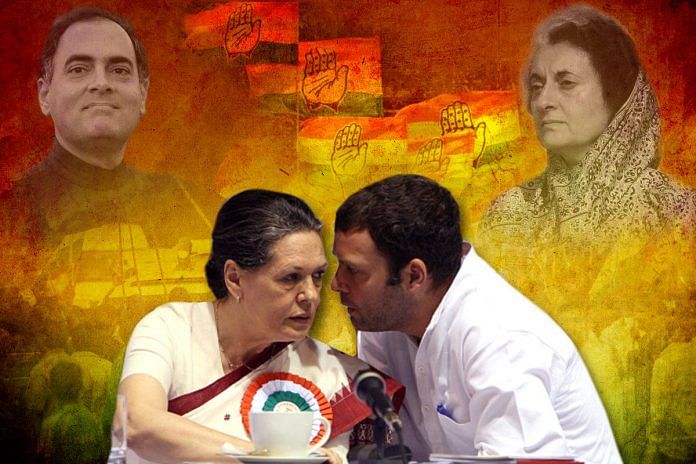Rahul Gandhi does not have to establish himself in the central leadership of Congress but will have to build state leaderships like Sonia did.
Talk about Rahul Gandhi’s politics and his leadership and the first comparisons that are drawn are either with his father or his grandmother. As deep and strong as their influence may be on the new Congress president, the biggest legacy Rahul will have to cope with in reality is that of his mother – Sonia Gandhi, the longest serving president of the grand old party.
In fact, Rahul is very much a part of this legacy. Through these years, he was at the heart of the family consultation process, which by all accounts Sonia Gandhi took very seriously ahead of several crucial decisions. So Rahul not only had a ringside view but a contributing role to his mother’s presidency.
By some strange coincidence, there are broad similarities in the political contexts of Sonia and Rahul rising to the top position in the party.
Sonia Gandhi took charge on 14 March, 1998, barely two weeks after the Congress was defeated in the general elections. Gujarat was one of the states where assembly elections were also held simultaneously. The BJP came out trumps in the state and has never lost it since.
But her presidency got a big boost by the end of that year, when Congress swept the polls in Rajasthan, Madhya Pradesh and Delhi. And a few months later in 1999, the party also won in Karnataka.
Rahul has the same line-up of states, minus Delhi, ahead of him. Except, of course, the order is a bit changed – Karnataka, Rajasthan, MP and Chhattisgarh, which was carved out of MP after 1998.
Broadly, Rahul is banking on the same clutch of state units as Sonia to strengthen his presidency. In many ways, the political calculation is that the Congress can only go on an upswing after the polls in Gujarat, where every little gain from 2012 will be a plus, a bonus.
At the same time, Sonia had a different set of challenges to deal with such as her foreign origin issue which led to Sharad Pawar’s separation from the Congress in 1999. She even resigned from the presidency then, leading to dharnas and hunger strikes by workers which saw her taking back her resignation.
Rahul Gandhi has no such imminent problem to tackle. Most of those upset with him have quit the party, which gives him somewhat of an encumbrance-free site to operate on. And that’s been the sort of opportunity he has had over the past seven years. The question has really been about performance.
Here, Sonia Gandhi was quite aware of her limitations. She surrounded herself with those who could deliver, not necessarily loyalists. Manmohan Singh, Pranab Mukherjee and P. Chidambaram flourished even though they were in the same proximity league as, say, A.K. Antony, Shivraj Patil, Digvijaya Singh or Ahmed Patel.
Her real strength came from the states, the leadership she nurtured there – Y.S. Rajasekhara Reddy (Andhra Pradesh), Tarun Gogoi (Assam), Sheila Dikshit (Delhi), Vilasrao Deshmukh (Maharashtra), Bhupinder Singh Hooda (Haryana) and Ashok Gehlot (Rajasthan), among others.
These CMs always gave the Congress president heft both within the party and outside. They also kept the party going as an election fighting organisation, be it by way of finances or reach.
In his initial years, Rahul Gandhi embarked on an exercise to reform the way this entire machinery functioned.
This ran against the grain of how the Nehru-Gandhi family has worked the Congress, as an effective party machine to come to power. Any reform was always done through the government, not the party, which had to be principally kept well-oiled and updated to win elections.
Sonia Gandhi chose not to become PM but formed the National Advisory Council that influenced government policy-making in a fundamental way. Rahul Gandhi’s more successful interventions like on MNREGA and the food security law were through this forum.
That separation of roles is a fundamental shift Rahul Gandhi will have to make as president. Sonia Gandhi never had this confusion. While parties must provide opportunity to aspirants, they often are decided on the yardstick of delivery and winnability.
The BJP is today a perfect example of that churn, where performers were given opportunities under a new presidency that did not come with a baggage of favourites. But unlike the Congress, the BJP leadership felt it has strong states and must strengthen its centre, which is still very much a work in progress.
Each party president has to find ways to create this balance. Unlike Sonia Gandhi, Rahul does not have to establish himself in the central leadership of the party but he will have to build state leaderships just like she did.
In doing so, he may have to overlook a bit, impose less but widen the tent, a task quite different now than in the heydays of the Congress when his father and grandmother ruled supreme.
Here, more of the Sonia Gandhi approach may help simply because the Congress is now no longer the only, let alone pre-eminent, force in national politics. The only Congress president other than her to face a bigger challenge on this score will be Rahul.



